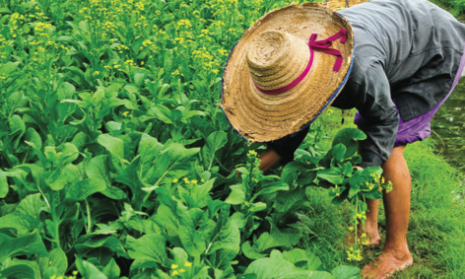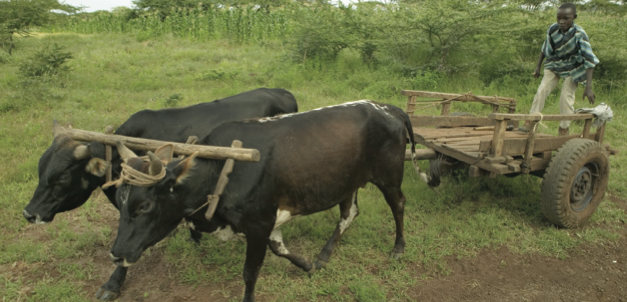Economics of GM crops in developing and developed economies

This journal exists because the world community faces a growing challenge to increase food supply at a rate that matches the demands of a growing and richer population.
Three articles in this edition of World Agriculture address important aspects of this problem. Two deal with the role of biotechnology in increasing productivity whilst protecting the environment; the third demonstrates how increased population pressure leads to the degradation of fragile farming areas.
Areal and colleagues use the techniques of Bayesian analysis to explore the evidence from published studies comparing the performance of GM and conventional crops.
A variety of GM induced characteristics are involved. These include resistance to pests and diseases and resistance to some herbicides. They can bring both agronomic and economic benefits, including higher yields and reduced use of crop production chemicals. They conclude that, overall, GM crops have outperformed conventional crops.
Critics have sometimes complained that biotechnology benefits farmers in rich countries but does not help farmers in low income countries where the need for more production is most critical. The authors conclude that the evidence suggests that developing countries that have adopted GM technology have significantly enhanced their food security.
Benefits arise not only for the innovating farmers but, as businesses that support farmers up and downstream expand, rural economies are stimulated.
They recognise that poor farmers who are unable to use the new technology may be disadvantaged. The solution proposed is income redistribution. This may be too facile. The cost and complexity of redistributing incomes is formidable even in rich countries with sophisticated public services. It rises disproportionately when the amounts to be transferred are small and where corruption is endemic.
Brooks and Barfoot explore the environmental and economic impacts of GM crops, basing their work on the published scientific literature.
They note the substantial area of GM canola, corn, cotton and soyabean now planted. They show that benefits arise in terms of both the environment and the economy.
The study focuses on two types of environmental impact, agronomic effects and greenhouse gas emissions. Their approach makes use of the environmental impact quotient developed by Kovach and colleagues in 1992 to measure environmental effects.
This uses some of the key data relating to toxicity and environmental exposure of individual products, as they impact on farm workers, consumers and ecology. This is a much richer approach than simply comparing changes in volume of active ingredient applied.
The paper reports a decline in the use of both herbicides and insecticides. It also notes that, in some places, the development of herbicide resistant weeds has become a problem. The authors point out that this is also a problem with conventional crops where weeds evolve to resist existing crop protection treatments.
To combat growing resistance a more sophisticated management programme is needed that uses herbicides with different modes of action as well as varying cultivation systems.
Greenhouse gas emissions are reduced as a result of using less fuel and leaving more carbon sequestered in the soil, as a result of low till and no till methods of cultivation.
They illustrate these gains in terms of the number of cars it would be necessary to take off the road to achieve an equal reduction in the release of CO2. Their conclusions are impressive, even though the gain in sequestered soil carbon is small.
GM crops increase farmers’ incomes both by raising revenue and reducing costs. Yields generally rise and the crop is of better quality. Costs fall because of reduced cultivation, despite higher prices for GM seed.
The authors compare, for each of the main GM traits, the performance of conventional and GM crops. They calculate substantial benefits from using GM technology claiming an overall increase of 6.5% in the value of the four major GM crops in 2010.
These calculations are essentially of changes in gross margin. They do not take into account any impact on overhead costs. In large scale such costs play an important part in determining overall profitability and the incentive to invest.
From a public policy perspective it is not only the impact on farmers’ incomes that matters but the net value
of the technology to society. For such purpose we need to know more about issues such as the impacts on the rural infrastructure, the external consequences for other business and tax receipts and the effect on a wider range of environmental services, such as amenity and the management of catchment areas.
This is not a criticism of the authors but an invitation for more work on the wider aspects of GM technology.
The paper by Barbier (pp. 23-28) draws attention to land degradation that occurs as the pressure of low income and growing numbers force poor farmers to use land that is much more fragile. Where such land is farmed by traditional techniques there is evidence of reduced land quality and erosion.
The problem is serious and urgent because of the scale of agriculture in the economies of poor countries. In broad terms 80% of the labour force is engaged in farming, 40% of GDP and most exports arise from agriculture. Since 1950 the population living in these fragile areas has doubled.
They are characterised by remoteness, poor access to markets and low incomes. The attempt to provide sufficient food for families to eat leads to the degradation not only of land but also of water resources.
The author argues that the only way to reduce this pressure is to enable farmers and their families to earn more income off the farm. Increased income from farming is not enough. What is needed is assured income from sources that do not increase the pressure on land. There is, however, some evidence that, when non-farm income rises some farmers may neglect their farms and fail to ensure soil conservation.
He proposes a radical shift in policy in order to generate a more sustainable system of farming in fragile areas.
The policy agenda includes direct payments to farmers for ecosystem services, investment to improve farm earnings, improved access to markets and investments in transport that will enlarge the area within which farming families can find work off their holdings.
Barbier’s critical message is that the things poor farmers are forced to do today in order to survive are likely to make their long term survival impossible.
His study forces us to realise that solutions to food production problems require responses that stimulate the economies of rural communities as a whole. The opportunities for agricultural improvement and environmental protection depend critically on the political and economic context within which farmers work.
His policy proposals are in line with current thinking about ‘agricultural policy’ in developed countries. We should not underestimate the difficulty and cost involved in making such policies work.
This emphasises the urgent need to refocus much existing policy, employing instruments that both relieve poverty in fragile rural areas and maintain a sustainable use of environmental resources.
Download pdfFigures

The Lewa Wildlife Conservancy, North Kenya, Africa.

